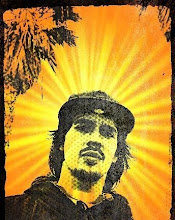
"Mexico's Forgotten Black History"
by griselda
For decades, he revolted against the Spanish crown. He lead an autonomous community of hundreds whose existence panicked the ruling classes from Mexico City to Veracruz. In 1609, his band survived a devastating incursion from the Spaniards, paving the way to an eventual negotiation - one that would make his community one of the first semi-autonomous communities recognized in the colonized Americas. Had an indigenous chief, rebellious priest or mixed peasant accomplished such a historical feat, it would not be hard to imagine their name still proudly spoken or recognized among Mexicans and Chican@s on both sides of the border. Gaspar Yanga, however, was brought to Mexico in chains. His original homeland is said to be what is now the African nation of Gabon. Aside from a lonely statue and yearly festival in what is now the town of Yanga, Veracruz, his legacy remains largely unknown.
This February, while reading articles on African-American history for Black History Month, I found myself contemplating my own history, and the part of Mexican history that was all but erased following the call of Vicente Guerrero (another Mexican of African descent) to abolish slavery during his short time as Mexico's president. Even though there were periods in which the African diaspora in Mexico greatly outnumbered Spanish colonialists, the modern narrative of Mexico is of a people and history shaped by the blending of two cultures - one European and one indigenous. Any mention of Mexico's "third root" is usually confined to a few scholars or various darker skinned communities in Mexico where African diaspora (many times alongside indigenous communities) were able to hold on to traditions and community.
The majority of Africans that came to Mexico were integrated - by force or social incentives that granted privilege based on race caste - into the post-colonized ambiguity of Mexicans, even as their existence was being conveniently forgotten. Under the influences of white supremacy and its lingering effects, it's not difficult to understand how generations have forgotten or obscured Mexico's African roots.
Sadly, though, even as Mexican or Chican@ nationalism confronted this colonial legacy, the mention of historical Black Mexico seems to offend those who think such expressions are a denial or rejection of Mexican's indigenous past. To this day in Mexico, those who identify as Afro-Mexican are waging a battle with the government to be officially recognized in the Mexican census.
The story of Gaspar Yanga, of the many Mexican "marooned" townships, of Black Seminoles and freed former slaves from the US in northern Mexico, and the eventual blotting out of Black history in Mexico are in my thoughts lately - while I assess the situation of my community north of the border, in this century. US capitalists may have replaced Spanish colonialists, but Blacks and Mexicans still find themselves as commodities, laborers, often used against one another. The divide and conquer tactics the conquistadors first used to split black/brown/white were modified and modernized and now apply to all workers of the Americas. This is partly why, as Mexicans and Chican@s, we should look at Black History not only as allies or students but because it's a part of our own history. And it must be a part of any future if we hope to accomplish what all of Mexico's defeated revolutions were not able to.
To honor Mexico's forgotten revolutionaries, as well as the celebrated ones, we need solidarity in the face of a common oppressor and socialism over a form of nationalism that doesn't engage or recognize all who struggle. We need to reclaim the dreams of those who gave and are giving their lives in struggle throughout the centuries on Mexican soil, and hear Yanga's grito along with Zapata's.
{Although stories of Black-Brown unity projects may not get the media attention, say, of Black and Latino gang rivalries in Los Angeles or disgruntled unemployed workers blaming immigrants, they are popping up in different parts of the country. This month in Georgia, I'm glad to say the Trail of Dreams - mostly undocumented students walking for immigration justice from Miami to DC - is being welcomed and hosted by traditional civil rights institutions as well as Black churches and community members/organizations.}
Original post: http://solidarity-us.org/current/node/2704



















